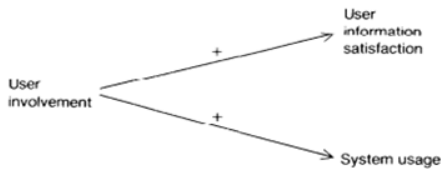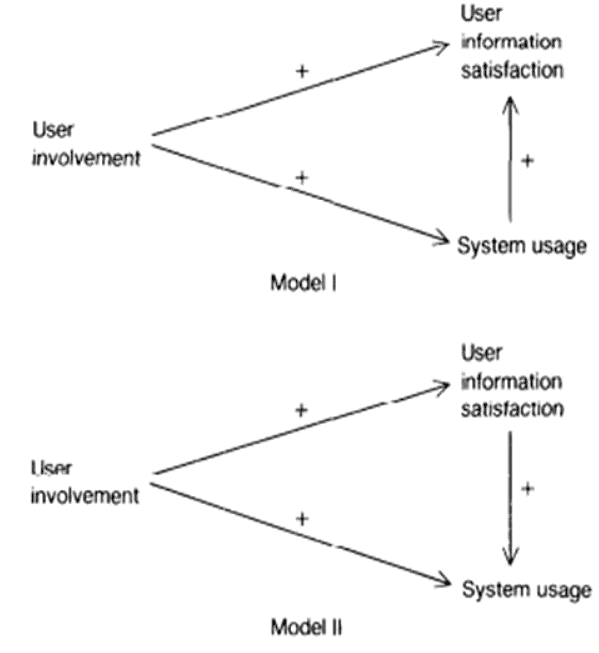User involvement | Management Optional Notes for UPSC PDF Download
Introduction
- User involvement is widely recognized as a critical mechanism to enhance system quality and ensure successful system implementation. It is emphasized in both business and political spheres as a means to drive innovation aligned with customer needs. In today's competitive and dynamic market conditions, innovations originating from customer needs are seen as an effective way to support market success. When users participate in the system development cycle, they provide detailed information that can significantly impact the outcome. However, users are often seen as ancillary in the development environment, with the development of systems typically carried out in isolation by data services.
- The effect of user participation on successful systems development has garnered significant attention from information systems researchers in recent decades. While involving users in the design of management information systems is recognized as valuable, it is also acknowledged to be time-consuming, costly, and potentially politicized. The assumption underlying user involvement is that their participation will offer valuable input to various technical decisions, particularly in socio-technical contexts.
- A review of empirical studies on user involvement identifies it as a key variable, defined as the subjective psychological state of users regarding the importance and personal relevance of a system. The concept of user involvement originated in the 1970s, focusing on the joint optimization of technical and social aspects of system design. In information systems, user involvement typically refers to participation in the system development process by potential users or their representatives.
- User involvement is often defined as the subjective psychological state where users perceive a system as significant and personally relevant. Studies often link user involvement to system quality, usage, attitudes, and information satisfaction. User participation, on the other hand, refers to observable behaviors and activities of users during the development process. While user involvement and attitude are psychological aspects, user participation pertains to observable user behaviors. It encompasses a set of operations and activities performed by users during system development, reflecting their degree of participative behaviors.
Theoretical Frameworks of User Involvement
Research on user involvement in information system design typically operates under the assumption that involving users leads to increased system usage, more favorable perceptions of system quality, or greater user information satisfaction. These constructs are often considered indirect indicators of improved decision-making performance, which is the ultimate goal of system implementation but challenging to measure.
- The Traditional Model: Various models explore the impact of user involvement on user information satisfaction and system usage, with the traditional model being one of them. This model posits that involving users leads to enhancements in both user information satisfaction and system usage. The rationale is that involvement fosters a deeper understanding of the system among users, making it better suited to their needs and thereby increasing motivation to use and satisfaction with the system. Empirical studies have produced mixed results regarding the relationship between user involvement and user information satisfaction, but many have reported a significant positive relationship.

- Theoretical Underpinnings: The assumption that user involvement enhances system usage and user information satisfaction aligns with theories of participative decision-making and planned organizational change. According to Ives and Olson, user involvement can be seen as a form of participative decision-making, which can lead to improved system quality and increased user acceptance, ultimately reflected in increased usage and satisfaction with the system. Involvement is viewed as essential for reducing resistance and increasing acceptance of planned changes within organizations.
Analysis of System Usage and Information Satisfaction
While the theoretical literature emphasizes the causal relationship between user involvement, system usage, and user information satisfaction, it is silent on the causal relationship between system usage and user information satisfaction. Building upon the traditional model, two competing models are proposed to explain this relationship. Model I suggests that as system usage increases, so does user information satisfaction, as increased usage leads to greater familiarity with the system and the discovery of new uses, enhancing user satisfaction. In contrast, Model II posits that higher user satisfaction with the system leads to increased system usage, assuming that satisfaction results from the system meeting user needs, thereby encouraging further usage. Conversely, if system use fails to meet user needs, satisfaction will not increase, and further use will decline.
Alternate Models

The information system, with system usage being a behavioral aspect, finds theoretical support for both models in the relationship between attitudes and behaviors. Fishbein and Ajzen's model of attitudes and behaviors suggests that attitudes toward an object shape intentions, which in turn influence behavior concerning that object (such as using the system or its outputs) (1975). This framework can be interpreted as endorsing Model II, where user information satisfaction (an attitude) drives system usage.
Importance of User Involvement
Significance in System Development
- User involvement is a crucial facet of system development, with many methodologies prioritizing user input. Unlike the perspectives of analysts or programmers, user involvement emphasizes the insights of end-users, fostering several vital aspects within information system development.
Understanding Current System Environment
- During the feasibility and design phases, developers must grasp existing issues and requirements. Given their limited familiarity, developers often rely on effective communication with end-users to comprehend the system thoroughly. This necessitates careful selection of users to maximize information extraction due to resource constraints.
Facilitating Methodological Efficiency
- Incorporating user input facilitates the selection of suitable methodologies, streamlining data assessment and validation. Furthermore, user involvement simplifies the process of designing and validating system functionalities, ensuring alignment with user needs.
Enhancing System Usability
- User involvement aids in organizing system features based on user data, mitigating usability issues stemming from developers' oversight of user habits. By reducing clashes between developers and users, collaborative efforts yield consensus on system functions and features.
Language Alignment for Efficient Communication
- Aligning developers' lexicon with that of users expedites communication and system development. Leveraging users' expertise in the system environment enables developers to communicate effectively, thereby accelerating the development process.
Major Issues of User Involvement
Insufficient user involvement in system design contributes to underperformance in IT systems. While various methodologies incorporate user input, the degree of influence users wield in decision-making varies. Inadequate user influence risks discrepancies between system design and actual user needs, necessitating increased efforts to involve users more effectively.
Benefits and Challenges of User Involvement
Positive Outcomes of Effective Involvement
Studies indicate several benefits of user involvement in system design, including improved system quality, avoidance of unnecessary features, enhanced user acceptance and understanding, and increased organizational decision-making participation. However, mere participation in decision-making does not guarantee successful IT systems; the quality and extent of participation significantly impact system performance.
Advantages and Disadvantages of User Involvement
Advantages:
- Empowerment of Beneficiaries: Involving beneficiaries empowers them, giving them a sense of ownership and agency over the outcomes of the project or service.
- Skill Development and Confidence Building: User involvement provides people with the opportunity to learn new skills and build confidence through participation.
- Exposure to New Experiences: Participants are exposed to new experiences and opportunities, broadening their horizons and perspectives.
- Shaping Research According to Needs: User involvement shapes research according to the needs and views of beneficiaries, ensuring relevance and applicability.
- Monitoring and Feedback: Users can monitor the progress of research, address problems, and provide useful feedback, improving the overall quality and effectiveness of the project.
Disadvantages:
- Lack of Interest: Not all people may wish to be involved, leading to challenges in recruiting participants and sustaining engagement.
- Role Shift for Researchers: Researchers may need to adopt a different role, focusing on supporting rather than leading, which can require adjustments and additional efforts.
- Unmet Expectations: Expectations of beneficiaries may be raised, leading to disappointment if their views are not adequately considered or implemented.
- Conflict with Research Standards: There may be conflict between the expectations of the research community and the needs or preferences of users, particularly regarding scientific rigor.
- Time and Commitment Requirements: User involvement can require a significant amount of time and commitment from both researchers and participants, impacting project timelines and resources.
Factors Promoting User Involvement
- Focus on Users' Priorities: Organizations that prioritize users' concerns and enable channels of communication foster greater user involvement.
- Leadership Commitment: Strong leadership commitment, characterized by a facilitative approach, encourages user involvement and drives organizational change.
- Quality of Dialogue: Effective communication between users and decision-makers, characterized by honesty and openness, promotes meaningful user involvement.
- Presence of Users: Maximizing the presence of users in various settings facilitates their involvement and contributes to organizational change.
- Resources Allocation: Allocation of human and financial resources towards user involvement activities is essential for driving change.
- Policy and Funding Context: External strategies and funding requirements can act as catalysts for organizational change towards greater user involvement.
- External Support and Scrutiny: External support from investigators, consultants, and user organizations adds legitimacy and motivation to user involvement efforts.
- Equality of Opportunity: Ensuring equality of opportunity for users at all levels of the organization promotes inclusive and representative user involvement.
- Continuous Monitoring and Evaluation: Regular monitoring and evaluation of user involvement practices facilitate ongoing learning and improvement.
Barriers to Implementing Change
- Fragmentation: Fragmented approaches to user involvement within organizations can impede coordinated efforts and hinder progress.
- Leadership Styles: Leadership styles that prioritize control over facilitation may hinder effective user involvement initiatives.
- Glass Ceilings: Barriers preventing service users from reaching higher levels of involvement can limit the effectiveness of user participation.
- Fashion and Rhetoric: Initiatives driven by image rather than substance may undermine the credibility and impact of user involvement efforts.
- Involvement of the Few: Over-reliance on a small group of users can limit the diversity of perspectives and hinder broader participation.
- Staff Turnover: High staff turnover can disrupt relationships with users and impede the continuity of user involvement efforts.
Conclusion
- User involvement in information systems pertains to the active participation of potential users or their representatives in the development process. It is measured through various behaviors and activities exhibited by these individuals. User involvement is widely regarded as a crucial factor for success in information systems development (Ives & Olsen, 1984). However, there are differing perspectives among experts. Some view user involvement as challenging, while others, particularly information systems professionals, may see users as incapable of making informed decisions and view their involvement as complicating the design process (Oliver and Langford, 1987), leading to their exclusion from decision-making whenever feasible.
- Beath and Orlikowski (1994) have noted a contradiction between the advocacy for "strong user involvement" in certain development methodologies and the actual extent to which users can effectively collaborate as co-agents with IS professionals. To address this, some researchers have proposed alternative methodologies that facilitate greater user involvement in commercial IS development, sometimes using only parts of a methodology (Mumford and Henshall, 1983). Effective user involvement in systems development, along with an overall user-centered approach, is crucial for the success of any development project and plays a significant role in managing information.
FAQs on User involvement - Management Optional Notes for UPSC
| 1. What are theoretical frameworks of user involvement? |  |
| 2. Why is user involvement important in system development? |  |
| 3. What are the benefits of user involvement in system development? |  |
| 4. What are the challenges of user involvement in system development? |  |
| 5. What factors promote user involvement in system development? |  |















